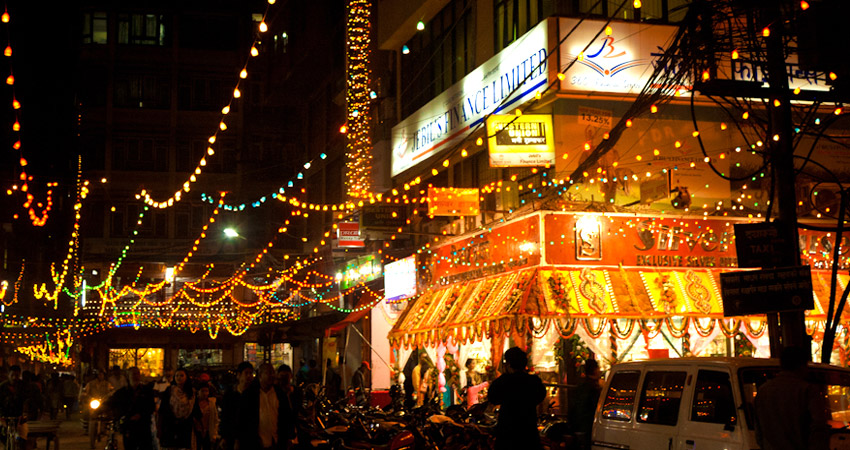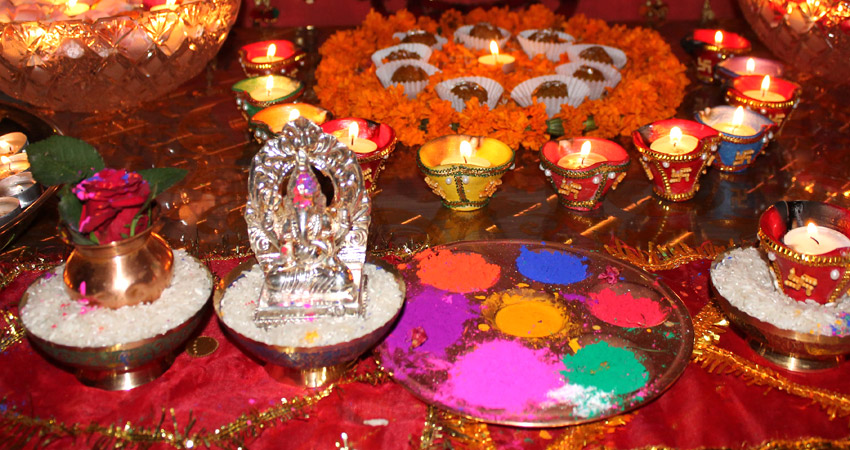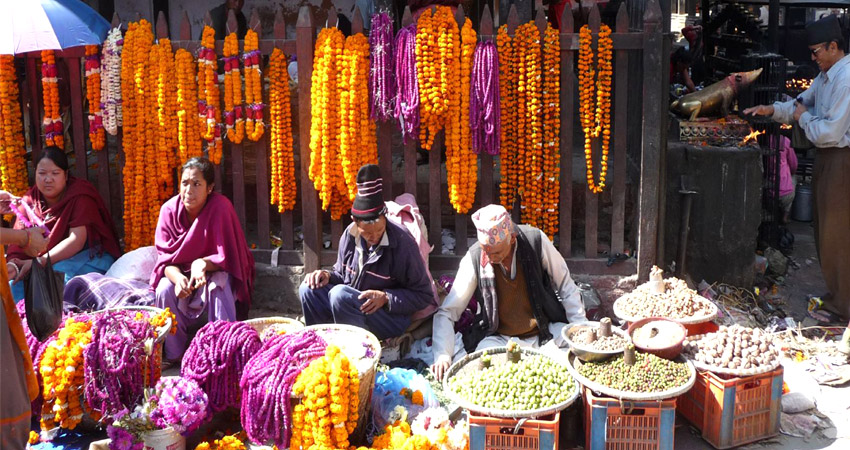Tihar Festival, Nepal Festival of Lights and Flowers

Nepal is a multilingual and multicultural nation with many feasts and festivals that people celebrate annually. Every festival holds a sacred value; most of the time they represent victory of God over the Devil or to commemorate the birthday of some deity. Among these, Deepawali is the largest national festival and is celebrated in late October. Tihar is one of the most colorful and important festivals of Nepal and is locally called as Deepawali or Diwali.
All Nepali festivals are celebrated as per the traditional Nepali calendar and also differ as per the area, the ethnic groups, the religions, and the cultures and traditions followed in the area. From Jatras to the biggest one – the Dashain, every festival has its peculiarities of the culture. Tihar also called the Festival of lights, is the second largest festival after Dashain. At this time homes are decorated with candles and lanterns to welcome the goddess Laxmi who is considered a symbol of wealth and richness.
Tihar comes shortly after Dashain and during this festival, Kathmandu becomes illuminated at night. It is celebrated between mid-October and mid-November and includes the honoring of crows, dogs, cows, and the goddess Laxmi.
Tihar festival is celebrated after the Dashain festival.
Tihar is the second big festival of Nepal that is being celebrated for five days with much rejoice. Hindu people celebrate Tihar for 5 days, each day having different rituals, beliefs, and symbolisms.
The festival starts with the worshipping of crows which are regarded as “the messengers of death”. People pay homage to the dogs on the second day declaring that dogs are protectors of the god of death. The third day of Diwali is the main festival in which people pray to the goddess Laxmi, the goddess of wealth. The fourth day is for cows, which is the national animal of Nepal and cows are worshipped on this day.
The fifth day of Tihar is called Bhaitika or Tihar Tika. This is an occasion when brothers and sisters usually take gifts to each other to show their solidarity. Families are reunited for this cheerful day, even those who live in different towns and cities, can sit with family members to share happiness while having a good meal.
Tihar Festival 2024 will be celebrated from 30th October to 3rd November 2024. The Nepali dates hold the Nepali year 2074 which begins on Kartik 14 and ends on Kartik 18 of 2081.
| Date | Day | Activities |
| October 30 2024 | Kaag Tihar | Honoring crows by providing food offerings. |
| October 31 2024 | Kukur Tihar | Honoring dogs by offering meals. |
| November 01 2024 | Laxmi Puja | Honoring cows and Goddess Laxmi, and participating in Bhaile festivities. |
| November 02 2024 | Goru Tihar | Honoring oxen and performing Gobhardhan puja. |
| November 03 2024 | BhaiTika | Honoring brothers and sisters and exchanging gifts. |
Here are the first essential things Nepalese people do in Tihar:
- Transform your home with the perfect color.
- Involve the entire family in the process.
- Celebrate with firecrackers.
- Share best wishes with friends and family through messages and social media.
- Engage and connect with other people in the community.
Traditions of the Tihar Festival
Tihar is the second biggest festival in Nepal after Dashain, which takes place over five days. The Tihar festival has a special importance and different activities are performed in each day of Tihar. The first day is dedicated to worshipping crows, which is believed to be ‘the messengers of death,’
The second day of Tihar is celebrated for dogs as they are regarded as “the protectors of the god of death.” The third day is dedicated to the ritual of welcoming the goddess Laxmi. The fourth day includes the celebration of animals, specifically cows, which are the national animal of Nepal. The last day of the festival is referred to as Bhai Tika or Tihar Tika and it is a day when brothers give gifts to their sisters and vice versa. Family members who are away from home gather to joyfully celebrate, sharing happiness and indulging in delicious meals.
Here is a detailed description of each day of the Tihar festival and the meaning they hold.
Day 1: KaagTihar/Crow Day
Activities: worshiping crows
Date: October 30, Wednesday
Kaag Tihar is the first day of the Tihar festival in which people offer rice to crows which are regarded as “the messengers of the death.” This day is considered as a holiday for crows, as these birds have been active throughout the year. They are worshipped today because a miserable crow is thought to bring dreadful news along with an ill fate that is going to unfold in the subsequent year.
It is a tradition to leave sweets and dishes on the roofs to attract crows and Ravens. In Hindu traditions, it is believed that the sound produced by ravens or crows symbolizes sadness or grief. In response, worshippers feed these birds with sweet foods to protect them from experiencing pain or having a painful day in the future days. It also has its own meaning of the sacred relation between people and the other animals.
Day 2: Kukur Tihar/Dog Day
Activities: Thanking dogs
Date: October 31, Thursday
Kukur Tihar is the second day of the Tihar festival that is mainly celebrated to pay respect to the dogs. In the Newar community, this day is called Kicha Puja. In this context, Nepalis pay respect to dogs as they consider the dogs as that animal who leads the dead soul to heaven. People cook food for the dogs and after that the people adorn the dogs with Tihar Tika and flower garlands. Dogs are regarded as “the guardians of death” and believed to be the messengers of Yamaraj – the god of death. It is also known as Narka Chaturdashi.
Day 3: Laxmi Puja
Activity: Worshiping Goddess Laxmi
Date: November 01, 2024, Friday.

The third day of Tihar is also known as Laxmi puja which is of great significance. On this day, people also pay respect to cows, as they are regarded to be goddesses of wealth in Hinduism. Cows have always been of great help in the past and in appreciation, people decorate them with necklaces and offer them the best grass to eat.
This day is also linked with welcoming the Goddess Laxmi to homes, and people believe that she resides in clean and well-decorated homes. Thus, the houses are cleaned well or even swept and the doors and windows are decorated with marigold (Sayapatri) flowers.
Houses are thoroughly cleaned and elegantly decorated, as this act is believed to attract the blessings of Goddess Laxmi, bringing wealth and prosperity to the home.
In the evening, people pray to the Goddess Laxmi who is the goddess of wealth and richness so as to thank for the blessings. People burn oil lamps (Diyo) or candles at front doors and windows for welcoming of prosperity and well-being.
Moreover, girls perform the Bhaili dance, or dance folk Bhailo songs from house to house in the neighborhood. They are rewarded with money and sweets; the children in particular are allowed to divide the portions among themselves. The night is enchanting as the whole country is illuminated which forms a breathtaking spectacle.
Day 4: Govardhan Puja/Guru puja
Activity: worshiping Oxen
Date: November 02, 2024, Saturday
The fourth day of Tihar is called Govardhan Puja, Goru Puja, or Omaha Puja, and its celebration depend on the culture of the people. It is a day to pay respect to the ox, which is a useful animal for farmers, through performing Goru Puja. This day is also celebrated as Omaha Puja, which is the Newa New Year’s Day in Nepal.
The Newari community gathers at night to celebrate Maha puja/Ma puja, or self-worship. Families gather for special feasts, enjoying foods considered auspicious, such as boiled eggs, fried fish, and various desserts. Devotees of Vaishnavism celebrate Govardhan Puja by offering prayers to the Govardhan Mountain, which is represented by cow dung. There is a colorful lighting of the night which adds more charisma to the festive activities.
In the night boys particularly sing Deusi which is stories of the festival where one boy performs the role of a main character and others respond as a chorus. They also accept monetary and fruit baskets and Selroti which are offered by the homeowners.
Nowadays it is also sung and participated in by some social workers, politicians, and young people by visiting one home and singing these songs. The money they gather through Deusi is often used for social purposes such as charity and social initiatives.
Day 5: Bhai Tika
Activities: Worshiping Brothers and Sisters
Date: November 03, 2024, Sunday

The final day of the Tihar festival is celebrated as the ‘Bhai Tika’. This is a day that is special to brothers and sisters who come together after a long time to rejoice in this auspicious day. The term Tihar is also used for “Yampanchak.” On this day brothers and sisters meet each other. Sisters put a colorful dot called Tika on their brother’s forehead and adorned them with beautiful garlands, and present sweets called Shagun as gifts.
In return, brothers also have their own unique way of paying their respect to the sisters by putting Tika on the forehead of the sisters and offering them some money. The festival is intended to enhance the relationship between the brothers and the sisters, and the Tihar or the Deepawali is one of the successful celebrations of this bond. In Bhai Tika, sisters put Saptarangi Tika or Tilaka on the forehead of brothers and the brothers put the same on the forehead of sisters. The sisters also pray for the fine and prosperous lives of their brothers and a successful life in the future.
Nepal Dog Festival 2024/2025
The Nepal Dog Festival is an annual Hindu occasion held all over the country of Nepal. This occur on the second day of Tihar, which usually falls in the months of October and November. Traditionally on this day, people pay respect to dogs through feeding them some delicious foods and placing small ornaments such as marigold flowers around the dog’s necks. This act is performed in order to appease Yama, the god of death, as dogs are believed to be his incarnations.
Importance of the Tihar Festival in Nepal:
The Tihar festival is also known as the festival of lights and is celebrated for victory over evils. It also strengthens the relationship between man and the animals through observation of crows, cows, dogs, and oxen. The joys involved the preparation of a number of delicious meals, feasting, washing houses, putting on new clothes, and many other ways. This festival is a public holiday for schools, colleges, and offices.
Lamps and windows in the houses and shops are brightly illuminated at night during the festival, and the sky dazzles with beautiful fireworks. People visit friends and relatives to exchange Tihar gifts during the festival. People celebrate it by wearing new clothes and they also make a new resolution to start a new life in life.
That is why it is important to celebrate such festivals to strengthen the bond of people and free from day-to-day tensions. Some of the cultural practices entail preparing yummy foods; flying kite; beautifying houses and streets.
Playing cards is a popular pastime during this festive season, helping to preserve our culture and traditional songs.
Although the Tihar festival lasts only a short time, it is one of the most enjoyable celebrations. Many people engage in dancing, singing, playing cards, and various delightful activities.
Main Attraction Of Tihar Festival
After Dashain, Tihar is the second-largest festival in Nepal, and the government typically provides a three-day national holiday for its celebration. This unique festival honors not only the gods but also animals such as crows, cows, and dogs, which have coexisted with humans for a long time.
As a sacred welcome for the gods and goddesses, especially Lakshmi, Nepalis often create decorative designs on the floors of their homes or gardens using materials like colored rice, dried flour, colorful sand, or flower petals, known as Rangoli. These designs enhance the energy and vibrations of the environment. Various attractions of Tihar can be experienced at any given time, with the festival’s highlights including worshiping animals as a sign of gratitude for their protection and contributions to agriculture.
During the festival, people pray to Lord Yama, the deity of death, for fair judgment regarding mortality. They also worship Goddess Lakshmi, who is believed to have been born during Tihar, in hopes of securing success and prosperity in life. Additionally, Govardhan Mountain is honored, as it is thought to protect the community from floods during the festival.
Although the Nepali government has recently imposed restrictions on firecrackers due to rising injuries, they are still commonly used during the celebration. However, it is essential to use them safely and responsibly. Children often go from house to house singing and asking for food and money in exchange for small gifts.
Card games, including the shell game kauda and langur burja, are a common pastime during the festivities. The event is distinctive for honoring both the gods and animals, such as crows, cows, and dogs, which have long shared life with humans.
Things to explore during the Grand Tihar Festival in Nepal
Tihar is an excellent time for tourists seeking authentic interactions with locals in Nepal. Due to their hospitality, Nepalis often invite visitors into their homes to share meals and celebrate the festival together. However, there are various ways to experience Tihar in Nepal beyond joining a Nepali family.
On Bhai Tika, the fifth day of the Tihar festival, the public can access the Matrikeshwar Mahadev temple, dedicated to one of Lord Shiva’s incarnations. This temple is situated in the heart of Kathmandu, surrounded by an artificial pond measuring 400 square meters. Crossing the charming white bridge to reach the temple grounds is a delightful experience, and the stunning white elephant sculptures adorning the temple walls are sure to captivate you.
If you find yourself in the area, make sure to plan your visit for the fifth day of Tihar to witness the breathtaking sunrise illuminating this tranquil scene of white beauty. Additionally, you can visit the Rani Pokhari Temple, which opens to the public only once a year during Bhai Tika. You can take a leisurely walk around the serene pond and enjoy views of the nearby town.
Kathmandu street Visit
As the sun sets, the ground is adorned with vibrant rangoli designs, and candles illuminate the surroundings, creating a festive atmosphere everywhere. The Tihar festival brings a unique, lively, and enchanting energy. Anyone can appreciate the ambiance and culture while joining in on these beautiful celebrations. I hope this gives you an idea of what Tihar is like in Kathmandu.
Explore Kathmandu, which is filled with stunning lights, religious celebrations, cultural performances, and festive activities. You can shop for gifts at the famous Thamel Market and witness rituals at breathtaking temples. Children light sparklers and set off firecrackers while fireworks light up the sky. As you wander through the streets, you’ll experience different vibes and a sense of positive energy.
You can immerse yourself in the festival by participating in the same rituals as the locals. Venture into the streets wearing your red tika and marigold garlands, bringing along some treats to celebrate Kukur Tihar and express gratitude to dogs for their loyalty.
Explore Markets
The market comes alive with an exhilarating atmosphere during the Tihar festival. Every shop and market is adorned with beautiful lamps and lights. Homes and businesses are decorated with marigold garlands draped over their entrances, while storefronts feature charming, vibrant murals. The effort put into making everything look stunning is truly remarkable.
It’s delightful to see people enjoying the Tihar festival. Shoppers are seen buying sweets and treats from small vendors. There’s so much to observe and experience at every turn. Visiting the town or bazaar is especially exciting when it’s illuminated and bustling with activity. The market even offers special festival sales during this time.
